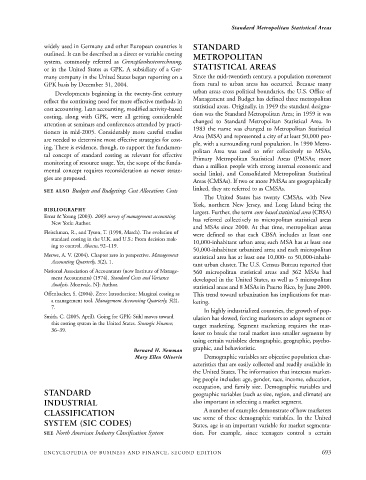Page 716 - Encyclopedia of Business and Finance
P. 716
eobf_S 7/5/06 3:21 PM Page 693
Standard Metropolitan Statistical Areas
widely used in Germany and other European countries is STANDARD
outlined. It can be described as a direct or variable costing METROPOLITAN
system, commonly referred as Grenzplankostenrechnung,
or in the United States as GPK. A subsidiary of a Ger- STATISTICAL AREAS
many company in the United States began reporting on a Since the mid-twentieth century, a population movement
GPK basis by December 31, 2004. from rural to urban areas has occurred. Because many
Developments beginning in the twenty-first century urban areas cross political boundaries, the U.S. Office of
Management and Budget has defined three metropolitan
reflect the continuing need for more effective methods in
statistical areas. Originally, in 1949 the standard designa-
cost accounting. Lean accounting, modified activity-based
costing, along with GPK, were all getting considerable tion was the Standard Metropolitan Area; in 1959 it was
changed to Standard Metropolitan Statistical Area. In
attention at seminars and conferences attended by practi-
1983 the name was changed to Metropolitan Statistical
tioners in mid-2005. Considerably more careful studies Area (MSA) and represented a city of at least 50,000 peo-
are needed to determine most effective strategies for cost-
ple, with a surrounding rural population. In 1990 Metro-
ing. There is evidence, though, to support the fundamen-
politan Area was used to refer collectively to MSAs,
tal concept of standard costing as relevant for effective
Primary Metropolitan Statistical Areas (PMSAs; more
monitoring of resource usage. Yet, the scope of the funda-
than a million people with strong internal economic and
mental concept requires reconsideration as newer strate-
social links), and Consolidated Metropolitan Statistical
gies are proposed.
Areas (CMSAs). If two or more PMSAs are geographically
SEE ALSO Budgets and Budgeting; Cost Allocation; Costs linked, they are referred to as CMSAs.
The United States has twenty CMSAs, with New
York, northern New Jersey, and Long Island being the
BIBLIOGRAPHY
largest. Further, the term core based statistical area (CBSA)
Ernst & Young (2003). 2003 survey of management accounting. has referred collectively to micropolitan statistical areas
New York: Author.
and MSAs since 2000. At that time, metropolitan areas
Fleischman, R., and Tyson, T. (1998, March). The evolution of
were defined so that each CBSA includes at least one
standard costing in the U.K. and U.S.: From decision mak- 10,000-inhabitant urban area; each MSA has at least one
ing to control. Abacus, 92–119.
50,000-inhabitant urbanized area; and each micropolitan
Merwe, A. V. (2004). Chapter zero in perspective. Management statistical area has at least one 10,000- to 50,000-inhabi-
Accounting Quarterly, 5(2), 1.
tant urban cluster. The U.S. Census Bureau reported that
National Association of Accountants (now Institute of Manage- 560 micropolitan statistical areas and 362 MSAs had
ment Accountants) (1974). Standard Costs and Variance developed in the United States, as well as 5 micropolitan
Analysis. Montvale, NJ: Author.
statistical areas and 8 MSAs in Puerto Rico, by June 2000.
Offenbacker, S. (2004). Zero: Introduction: Marginal costing as This trend toward urbanization has implications for mar-
a management tool. Management Accounting Quarterly, 5(2), keting.
7.
In highly industrialized countries, the growth of pop-
Smith, C. (2005, April). Going for GPK: Stihl moves toward ulation has slowed, forcing marketers to adopt segment or
this costing system in the United States. Strategic Finance,
target marketing. Segment marketing requires the mar-
36–39.
keter to break the total market into smaller segments by
using certain variables: demographic, geographic, psycho-
graphic, and behavioristic.
Bernard H. Newman
Mary Ellen Oliverio Demographic variables are objective population char-
acteristics that are easily collected and readily available in
the United States. The information that interests market-
ing people includes: age, gender, race, income, education,
occupation, and family size. Demographic variables and
STANDARD geographic variables (such as size, region, and climate) are
INDUSTRIAL also important in selecting a market segment.
CLASSIFICATION A number of examples demonstrate of how marketers
use some of these demographic variables. In the United
SYSTEM (SIC CODES) States, age is an important variable for market segmenta-
SEE North American Industry Classification System tion. For example, since teenagers control a certain
ENCYCLOPEDIA OF BUSINESS AND FINANCE, SECOND EDITION 693

